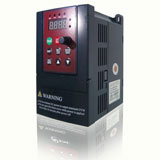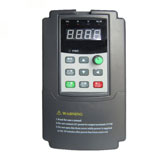HomeSolar inverters
These TL's are the highest efficiency, sickest inverter solution residential PV systems have ever seen. You really can tell which companies will, or want to, stick around to support their systems well into the future based on their inverter choices. It really does matter to the industry that folks understand macro, not just micro.
Keep in mind string and central inverter concepts are vastly different. For example you can use multiple string inverters for different orientations, string lengths or module types, or a central inverter even for different orientations, and the losses are incredibly small, so small where if this is your case, excluding string lengths & module types, I have very convincing data that shows it probably makes the most economical sense to stick with one inverter. Anyways, would love to hear your thoughts on the best scenarios for string and central inverters as well.
Micro inverter solutions typically have less wiring because there are no junction or combiner boxes. For ACPV solutions (panel-vendor integrated micro inverters), there may not even be grounding wires (other than for the metal components of the racking, depending on the AHJ). There are no DC arc fault requirements, because there is no DC. Most microinverter solutions on the market use PLC communications, instead of either RS-232 or RS-485 (SMA products).
In addition to the wide MPPT range ( 5 to 60 Vdc), there are a number of other benefits. The DC to DC converter plus inverter solution offers module level MPPT, module level monitoring, enhanced design flexibility (modules of different sizes, different mounting orientation, etc). All these benefits are common to all distributed technologies. The advantages of DC to DC based solutions over micro-inverters are lower cost, slightly higher energy yield, and more scalable system designs.
Using string inverters instead of central inverters for big power plants is a totally different concept, that affects to the whole management of the PV plant in some aspects:
1. Designing: with multi-MPPT string concept a better management of the shades is obtained. If lower row of the structure is connected to a different MPPT than upper rows, you can place structures closer, obtaining a best ratio of W/m2. Furthermore, cabins are smaller (and provoke less shadow) and marginal areas of the ground can be used (if the inverter is flexible enough), thus more panels can be installed in the same area, peaking down the costs (€/Wp) of LV cables, MV cables, fencing, security perimetral systems, etc. Moreover, it is not necessary to leave special rows for installation, because machinery used is lighter.
1. Designing: with multi-MPPT string concept a better management of the shades is obtained. If lower row of the structure is connected to a different MPPT than upper rows, you can place structures closer, obtaining a best ratio of W/m2. Furthermore, cabins are smaller (and provoke less shadow) and marginal areas of the ground can be used (if the inverter is flexible enough), thus more panels can be installed in the same area, peaking down the costs (€/Wp) of LV cables, MV cables, fencing, security perimetral systems, etc. Moreover, it is not necessary to leave special rows for installation, because machinery used is lighter.
 High quality frequency inverters for electric motor speed controls in energy-saving solutions.
High quality frequency inverters for electric motor speed controls in energy-saving solutions.
Search inverters
Category
inverters
Featured
 Single phase inverter normally is for small power electric motor speed adjustment applications, with single phase 220V to 240V input to three phase voltage ...
Single phase inverter normally is for small power electric motor speed adjustment applications, with single phase 220V to 240V input to three phase voltage ...
 This frequency inverter supplied by our factory integrated vector control function. This inverter can continuous running even if power supply off for a few ...
Frequency inverter manufacturers mainly focus on R&D in order to develop new and improved products, which offer more distinguished and revolutionary features ...
A frequency inverter changes output voltage frequency and magnitude to vary the speed, power, and torque of a connected induction motor to meet load conditions. ...
Frequency inverter reconstruction of Power Plant promoted heightening of economy benefit. Frequency inverter won acceptance of user as its high reliability, ...
Gozuk inverters are suitable in the fields of power, iron and steel, HVAC, oil, mine, construction, etc for the high-voltage motor's speed adjustment, energy ...
When adopting the frequency inverter to conduct speed adjustment, the fan speed will reduce from N1 to N2. As the fan's static pressure Pst=0, conforming to ...
This frequency inverter supplied by our factory integrated vector control function. This inverter can continuous running even if power supply off for a few ...
Frequency inverter manufacturers mainly focus on R&D in order to develop new and improved products, which offer more distinguished and revolutionary features ...
A frequency inverter changes output voltage frequency and magnitude to vary the speed, power, and torque of a connected induction motor to meet load conditions. ...
Frequency inverter reconstruction of Power Plant promoted heightening of economy benefit. Frequency inverter won acceptance of user as its high reliability, ...
Gozuk inverters are suitable in the fields of power, iron and steel, HVAC, oil, mine, construction, etc for the high-voltage motor's speed adjustment, energy ...
When adopting the frequency inverter to conduct speed adjustment, the fan speed will reduce from N1 to N2. As the fan's static pressure Pst=0, conforming to ...
Recent
60Hz to 50Hz Frequency Converter
50Hz motor running on 60Hz power supply
Single phase to three phase converter
Frequency converter typical shortcomings
Frequency Converter Troubleshooting
Frequency inverter, the best energy saving solution
Does Frequency converter better than control valves in flow controls
Frequency Converter for Pumps
Why AC motor needs a Frequency Converter?
Determining frequency converter size
Frequency inverter energy efficiency calculation
Frequency inverter for heavy duty application (mining)
50Hz motor running on 60Hz power supply
Single phase to three phase converter
Frequency converter typical shortcomings
Frequency Converter Troubleshooting
Frequency inverter, the best energy saving solution
Does Frequency converter better than control valves in flow controls
Frequency Converter for Pumps
Why AC motor needs a Frequency Converter?
Determining frequency converter size
Frequency inverter energy efficiency calculation
Frequency inverter for heavy duty application (mining)
